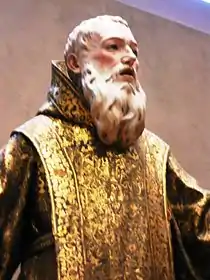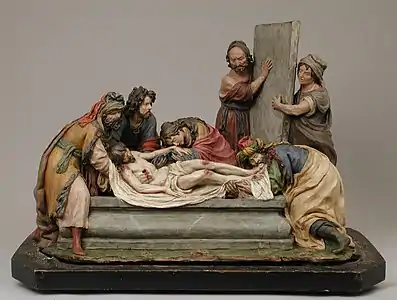Luisa Roldán
Luisa Ignacia Roldán (8 September 1652[1] – 10 January 1706), called La Roldana, was a Spanish sculptor of the Baroque Era. She is the first woman sculptor documented in Spain.[2][3] Roldan is recognized in the Hispanic Society Museum for being "one of the few women artist to have maintained a studio outside the convents in Golden Age Spain".[4]
Luisa Roldán | |
|---|---|
| Born | September 8, 1652 |
| Died | January 10, 1706 |
| Resting place | Parish Church of San Andrés, Madrid |
| Nationality | Spanish |
| Education | Her father, Pedro Roldán |
| Known for | Sculpture |
Because of the quality of her work, Antonio Palomino, considered her as important a sculptor as her father.[5]
Though Roldán was the "Escultor de Cámara", or Court Sculptor, to Habsburg King Charles II, she experienced financial struggles. Like many artists of her time she died poor, signing a declaration of poverty shortly before her death. On the day of her death, Roldan was given the title of "Academician Merit" from the Academy of Saint Luke in Rome.[6]
Life
Roldán was born in Seville, the daughter of sculptor Pedro Roldán and her mother was Teresa de Ortega.[7] She was taught by her father, alongside her siblings. Roldán apprenticed in her father's workshop. Also working within the workshop was Luis Antonio de los Arcos, who Roldán married when she was 19.[6]
Her marriage to de los Arcos was against her father's wishes. Santiago Montoto, writing in 1920, went so far as to characterize it as an "abduction" ("rapto"), perhaps revealing his lack of understanding of marriage customs of the period. Two of her sisters and one brother also encountered parental disapproval of their chosen partners. After she worked in Cadiz from 1686 to 1688.[8]
Roldán created her own workshop together with her husband and brother-in-law, Tomás de los Arcos, to create religious polychromed wooden sculptures. Roldán being the primary artist in carving[7] and her husband helped with his expertise in flesh painting and gilding.[9]
She created wooden sculptures as well as statues for the Cathedral of Cadiz and the town council.[8] In 1688 she moved to Madrid,[10] where she became court sculptor in 1692,[8] serving Charles II and Philip V; she also served the Duke of Infantado. Roldán gifted her Virgen con el Nino terracotta piece to the Accademia di San Luca, where she was admitted at the end of her life.[11] Nonetheless, she died in poverty in Madrid. She made attempts to quell her financial issues by writing to Charles II's second wife, Queen Maria Anna for help. Although the queen responded trying to aid her with money, it proved insufficient. Luisa's husband also gives effort to fix their economic situation by applying for a royal position, of which he is denied.[6]
Still, Roldán's husband had a role in marketing her work and extending her fame. The commission for the El Nazareno was from Charles II, but he died, leaving the statue to stay with the artist. Luis Los Arcos attempted to get the piece to Rome through recommendations of notable people, but the statue proved not to be to the liking enough of the supposed recipient.[11]
Roldán had seven children, of whom two survived to adulthood. Out of the five children who passed, two of them died from malnutrition.[7] During her time working for Charles II, Roldán, her husband, and their children suffered from hunger due to the country's economic crisis affecting the food supply.[12]
Works
| External video | |
|---|---|
 | |
Her works are strongly characterized as possessing "clearly delineated profiles, thick locks of hair, billowing draperies, and mystical faces with delicate eyes, knitting brows, rosy cheeks, and slightly parted lips."[8] The 'knitted brows' that are sometimes noted in her terracotta angels are not usually seen in her works in wood, which are characterized by open, evenly arched brows. Her St. Ginés de la Jara, made around 1692, is now at the Getty Center. Unlike the billowing cape of her St Michael in El Escorial, the robe worn by the Getty's San Gines is very still. Processional statues whose creation can be safely attributed to her include statues of the Virgen de la Soledad, Mary Magdalen, and Jesus.[13] In Cadiz, works by her include statues of Anthony of Padua, Ecce Homo, and Saints Servandus and Cermanus.[13]
Roldán was a prolific sculptor. Much of her work was religious sculpture for churches, and while living in Madrid she also made small terracotta works popular with the petty bourgeoisie. The smaller works could be used for personal devotion and took the forms of religious scenes, human forms and animals.[6] Her pieces were widely distributed in Andalusia, as well as in Madrid, Móstoles and Sisante (Province of Cuenca), New York, London, Ontario, Los Angeles and Chicago.
The following are among her most noted works that remain in churches:
- Most Holy Mary of Silence (María Santísima del Silencio), Jaén
- Carved wooden figures of San Servando and San Germán, patrons of Cádiz, in the Cádiz Cathedral
- Saint Joseph, Iglesia de San Antonio, Cádiz
- Saint Anthony of Padua, Iglesia de Santa Cruz, Cádiz
- Saint John the Baptist, Iglesia de San Antonio de Padua, Cádiz
- Our Lady of Sorrows of the Remedies (Dolorosa de los Remedios), Jerez de la Frontera
- Virgin of Solitude (Virgen de la Soledad), Iglesia de la Victoria, Puerto Real
- Ecce Homo, Cádiz Cathedral. 1684. Carved polychromed woo, 165 cm. The date was confirmed by a document found in its interior during a restoration by J.M. Sánchez Peña in 1984. The head, arms, hands and torso to hip height are in cedar, and the rest including the chlamys is in pine.[14]
- Ecce Homo, Córdoba
- Archangel Saint Michael conquering a demon, El Escorial
- Christ of the Pardon, (Cristo del Perdón), Fregenal de la Sierra
- Saint Ferdinand, Cathedral of the Canaries, (Gran Canaria)
- Penitent (Nazareno), Iglesia de las Hermanas Nazarenas, Sisante

A figure of Mary Magdalene in Cádiz was destroyed by fire at the outbreak of the Spanish Civil War in 1936.
Other notable works are in collections and museums:
- Museum of Fine Arts of Seville
- Death or Ecstasy of Mary Magdalene, Marriage of Saint Catherine, Hispanic Society of America, New York City
- Saint Joachim, Saint Ann and the Virgin as a Child (La Virgen niña con San Joaquín y Santa Ana) and Jesus' First Steps (Los primeros pasos de Jesús), Museum of Fine Arts, Guadalajara, Spain[15]
- Saint Michael, Royal Ontario Museum, Toronto, Canada.
- The Virgin Appears to Saint James Victoria and Albert Museum, London, England.
- The Entombment of Christ, Metropolitan Museum of Art, New York.
Notes
- Birth date is based on baptismal certificate. Catherine Hall van den Elsen. Roldana, Andalucía Barroca 2007. Junta de Andalucía, Consejería de Cultura. ISBN 978-84-8266-717-1. p. 21.
- [Gaze, D (ed) Dictionary of Women Artists, 1997, Fitzroy Dearborn, vol 2, pp. 1192-1195] Luisa Roldan (1650 - 1704) Artwork Images, Exhibitions, Reviews Archived 2016-10-18 at the Wayback Machine
- Although her dates of birth and death were discovered some years ago, many websites and publications still contain the incorrect dates.
- "Sculpture". Hispanic Society of America. 2015-11-25. Retrieved 2020-12-08.
- Dabbs, Julia, K. (2009). Life Stories of Women Artists, 1550-1800: An Anthology. Routledge. pp. 196–198. ISBN 978-0754654315.
- Bray, Xavier; Lenaghan, Patrick; Luis Romero Torres, Jose; Fontoira, Helene (2016). Luisa Roldán: Court Sculptor to the Kings of Spain. Translated by Jennings & A. E. Suffield, Nicola. Madrid: Coll & Cortés. pp. 4–22, 42–48.
- García-Martín, Elena (2012). "Gendered Representations of the Militant Church Ana Caro's and Luisa Roldan's Rhetoric of War and Religion". Early Modern Women. 7: 69–100.
- Luisa Roldán Archived 2013-03-13 at the Wayback Machine, Getty Museum. Retrieved 2010-04-30.
- Khandekar, Narayan; Schilling, Michael (2001). "A Technical Examination of a Seventeenth-Century Polychrome Sculpture of St. Gines de la Jara by Luisa Roldan". Studies in Conservation. 46 (1): 23–34.
- Her arrival there can be dated some time before 28 February 1688, when her daughter María Bernarda was baptized in the parish church of San Bernardo, Madrid. Catherine Hall van den Elsen. Roldana, Andalucía Barroca 2007. Junta de Andalucía, Consejería de Cultura. ISBN 978-84-8266-717-1. p. 25.
- Estrella, Felipe Serrano (2013). "State gift or strategy? La Roldana's Nazareno". Sculpture Journal. 22 Issue. 2.
- Heller, Nancy G. (2002). Women Artists: An Illustrated History (4th ed.). New York: Abbeville. p. 51. ISBN 978-0-789-20768-5. OCLC 54500479.
- Cádiz Cofrade - Imaginería
- Antonio Torrejón Díaz: Roldana Andalucía Barroca, 2007. Junta de Andalucía. p. 174. ISBN 978-84-8266-717-1.
- Fernando Aguado, Cámara de las Maravillas de Guadalajara Archived 2010-10-02 at the Wayback Machine, patrimoniohistoricoclm.es. Retrieved 2010-04-30.
External links
| Wikimedia Commons has media related to Luisa Roldán. |
- Artcyclopedia
- Biography of Luisa Roldán from the J. Paul Getty Museum
- Exhibition: La Roldana's Saint Ginés: The Making of a Polychrome Sculpture
- World Wide Arts bio
- (in Spanish) La Roldana
- (in Spanish) Luisa I. Roldán, La Roldana: Breve Reseña Biográfica
- Gaze, D (ed) Dictionary of Women Artists, 1997, Fitzroy Dearborn, vol 2, pp. 1192–1195
